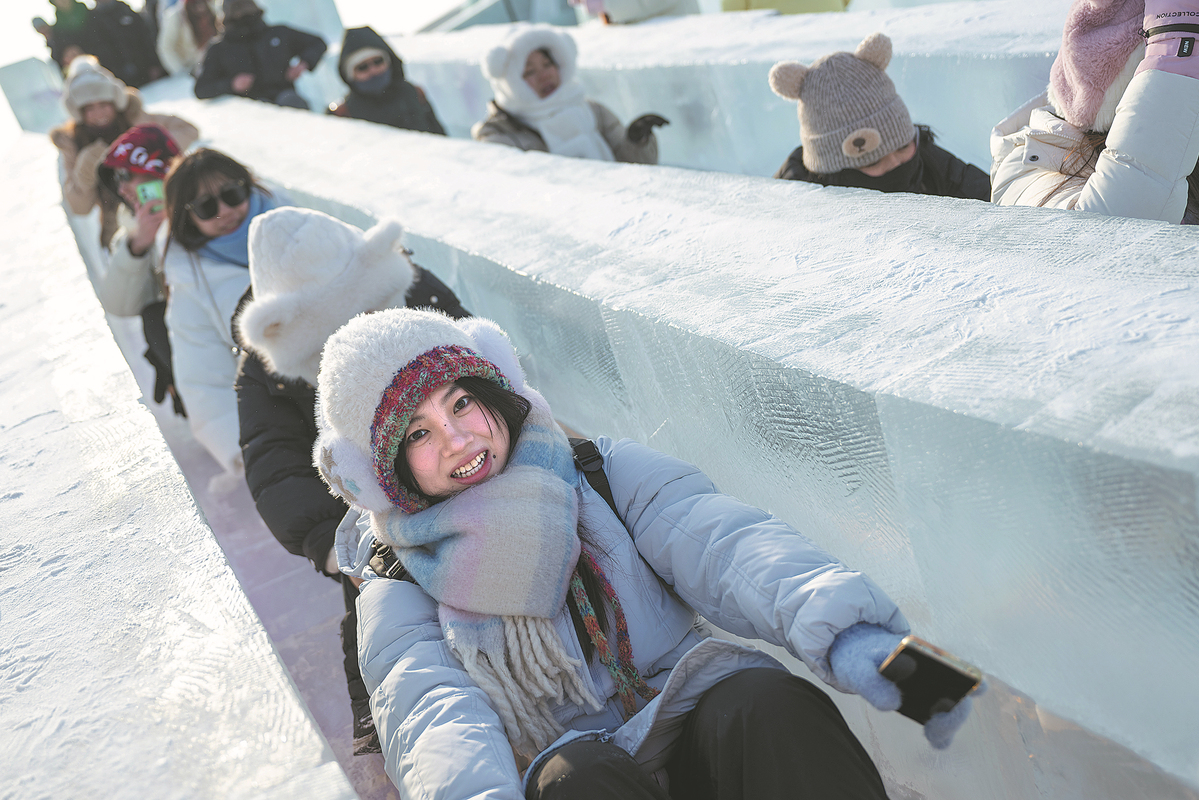
 0 Comment(s)
0 Comment(s) Print
Print E-mail China Daily, December 23, 2024
E-mail China Daily, December 23, 2024

Tourists enjoy a ride on an ice slide at the Harbin Ice and Snow World on Saturday. [Photo/Xinhua]
Winter tourism and sports continue to heat up in China, with temperatures in the north having dropped to the freezing point or below, while some overseas ice and snow destinations are also enjoying the spillover from Chinese people's strong demand for winter activities.
Some online travel agencies have given encouraging reports, showing that winter tourism products have seen more bookings as frostier weather settles in. The travel portal Trip.com Group said that winter tourism bookings began to increase in late November, with searches for such tours remaining popular on the platform this month.
Li Shengwen, a manager at travel portal Tuniu, said she noticed that bookings for winter sports such as skiing and ice-skating have witnessed rapid growth since late October, and that demand for these products has been especially high in December.
Traditional domestic winter tourism destinations such as Harbin, in Northeast China's Heilongjiang province, and Northwest China's Xinjiang Uygur autonomous region are top choices for travelers for their fairy tale-like snow views and good facilities for skiing enthusiasts, according to travel agencies.
Last week, China Railway Shenyang Group operated its first special winter tourism train of the year. About 210 travelers from the nation's eastern and southern provinces will experience snow scenery during their nine-day train trip, which began in Shenyang, the capital of Northeast China's Liaoning province.
Experts and industry insiders said that travelers, especially young people, are increasingly interested in winter sports, in addition to appreciating views of ice and snow, thanks to the public's growing awareness of winter sports since the 2022 Beijing Winter Olympics.
Ma Rui, a marketing director of Wu Shang Bonski, a company that operates ski domes and offers ski training and education, has noticed that some indoor ski facilities in central and southern provinces with milder climates — such as Hubei and Guangdong — have experienced brisk business in recent months.
"The colder the weather, the stronger the desire that people have for skiing," she said, adding that people living in southern or central provinces, places that don't often get snow due to their milder climates, also want to enjoy winter activities, but might not be willing to travel a long distance to winter tourism destinations.
"Under such circumstances, some travelers or winter sports fans choose to experience skiing at indoor domes, which is convenient and provides stable running ski tracks in all seasons," she said.
Some overseas winter tourism destinations and travel products have also seen increasing searches and bookings at Chinese travel portals, as many travelers seek diversified winter tourism or sports experiences.
Qi Chunguang, vice-president of Tuniu, said that while northeastern provinces remain the most sought-after winter tourism destinations for Chinese travelers, overseas winter destinations like Japan's Hokkaido have also gained popularity on the platform because of quality ski resorts and hot springs and, in the case of Hokkaido, exotic Japanese cultural vibes.
He said that winter tour products for travel to Nordic countries and for cruise trips to Antarctica during the coming Spring Festival holiday — which begins in late January — have been sold out on the platform.
Qi also noticed that more travelers have begun to try winter sports events like skiing or ice-skating during sightseeing trips.
"About half of current winter tourism bookings by our users to northeastern provinces for the Spring Festival holiday... include skiing," he said, adding that people between the ages of 26 and 35 are the major consumers of skiing-related products at the platform.
China has made continuous efforts to invigorate the winter economy. Under a recent guideline by the State Council, China's Cabinet, the nation will generate a new growth point in the winter economy by integrating the development of winter sports, winter tourism and winter gear and facilities. The nation is aiming for its winter economy to reach 1.2 trillion yuan ($164.5 billion) by 2027 and 1.5 trillion yuan by 2030.
Go to Forum >>0 Comment(s)